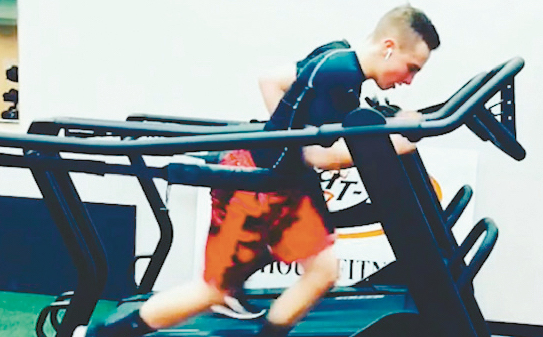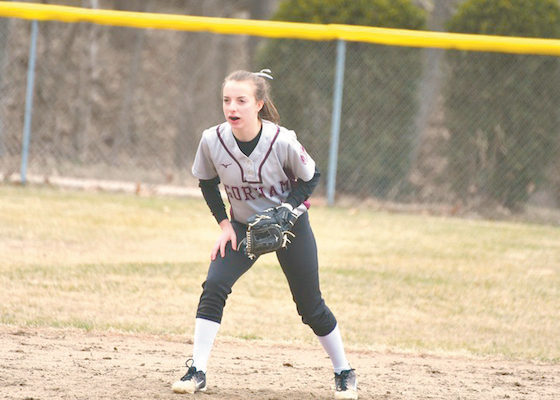When we think about professional athletes, we understand there is conditioning and preparation that goes into becoming elite and competing at the highest level. Conditioning is not only for the elite, however. It is also a part of many local athletes’ regimen as they prepare for their seasons.
Conditioning can improve an athlete’s performance including power, strength, speed, balance, agility, coordination, and endurance. Some athletes train for just one sport while many participate in multiple athletic activities. Some use a specific program to condition while others participate in school-sanctioned team activities such as lifting at the Gorham High School weight room during the summer, or follow a coach’s advice about which areas to focus on.
Stan Skolfield, owner of Skolfield Speed Performance, said, “Off- season strength and conditioning programs can have a number of essential benefits for youth athletes. The single most important benefit is injury prevention as well as the time it takes them to recover from an injury.” He also shared that a well-constructed program works to provide a solid athletic foundation.
Molly Murray, a junior at GHS, plays field hockey, participates on the indoor track and field team, and is also a member of the varsity softball team. Murray trains year-round for softball. “During the winter I have weight lifting every Sunday. In April I start high school softball, and this year during every practice we did circuits that included sprints, core and arm workouts,” she said.

Molly Murray
Murray’s conditioning for field hockey began in June. Those workouts included strengthening and speed training. While she doesn’t necessarily condition specifically for track, the preparation for her other sports helps her get ready for the season. She said off-season conditioning helps because she can focus on the fundamentals of each sport during the season.
Both Bode Coleman, who is heading into his freshman year (lacrosse), and Caleb Hendrix (baseball), a rising sophomore at GHS, condition for their sports. In order to prepare for his lacrosse season Coleman said he practices with his stick everyday. “I have a specific progressive strength training program that I complete twice a week. I also attend a group speed and agility workout twice per week.”

Bode Coleman

Caleb Hendrix
In addition, Coleman usually tries to get at least one long slow endurance workout (running, biking, swimming or rowing) each week. He trains with the next season in mind. “When I train, I feel stronger, faster, and overall, more fit. I want to be in the best condition possible each season, and I think about that with each training session.”
When looking at at the results of his extra training ahead of baseball season, Hendrix said, “I feel that I am faster this year. I had more endurance on the mound when I started the season.” With the season seven months away, Hendrix said he has a lot of time to continue to work for the results he hopes to continue to achieve.
Stacey Coleman, Bode’s mother and owner of My-Fit-24, said, “Each individual athlete could benefit from having a highly specific conditioning program prescribed for their specific starting point, goals, and needs.” She also shared that athletes can benefit from less specific programs that focus more on overall generic athleticism including speed, agility, cardiovascular endurance, and power.
Success stories about athletes who condition for their sports can be inspiring. Brogan McDonald (GHS ’18) is an example of how pre-season training can lead to successful sports seasons, even after high school. McDonald remembers when he was in fifth grade and wasn’t the most athletic kid. He was bigger than his peers and his coordination was lacking.

Brogan McDonald
“I remember my dad referring to the way I ran, calling me a ‘plow horse.’ Of course, it wasn’t a serious comment but I did take offense to it and I was normally looked at as one of the slower kids when it came to things like playground games and baseball.” In sixth grade, he hit his growth spurt and everything started to “click.” He then added a conditioning program which taught him to run properly and use his whole body to generate speed and power.
McDonald is now a goaltender playing junior hockey; he is also currently pursuing college hockey (NCAA). While he considers his offers to play college hockey, he is training three times a week with a strength coach where his focus is keeping his body mobile but also adding strength and muscle. “I skate twice a week with my goalie coach with yoga afterward,” he said.
Skolfield is also an influence on McDonald. “He hands down has helped me realize my full potential as an athlete in general. His workouts have made me into a completely different ‘beast’ as he would say.” From the meal plan to the unique stretches he incorporates, McDonald said he feels more confident when he walks out of a session and his hard work is paying off. “I’ve come a long way from the pudgy little kid I was then,” he said.
Conditioning prior to competing in a sport can be extremely beneficial to athletes who want to become better and stronger. If an athlete doesn’t have access to a professional, they can talk to their specific coaches about what plan might work for them. It might involve adding weight training at their school gym for strength or running/ sprinting for endurance and speed. Athletes have many options available to them in Gorham.
Skofield stated, “The stopwatch doesn’t lie. Before skill there is athleticism, the basis of all sports. Are you fast? Explosive? Strong? Can you move? Sport is movement. Simple.”


